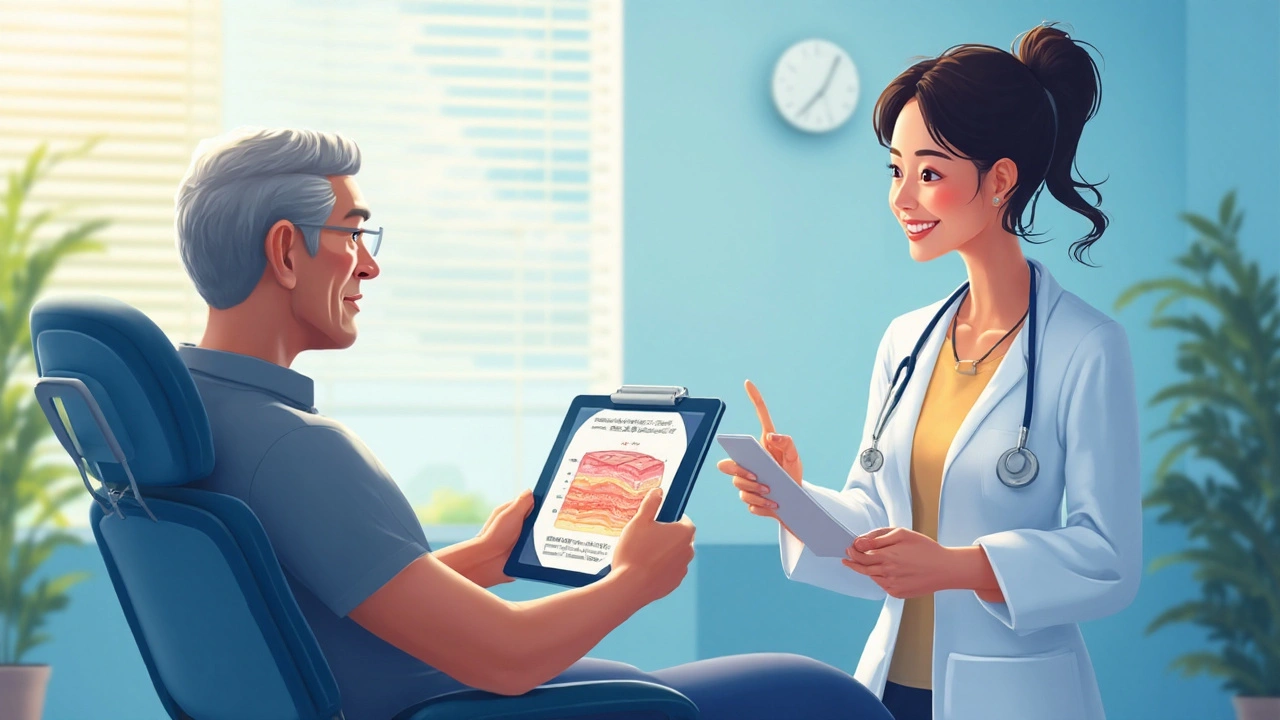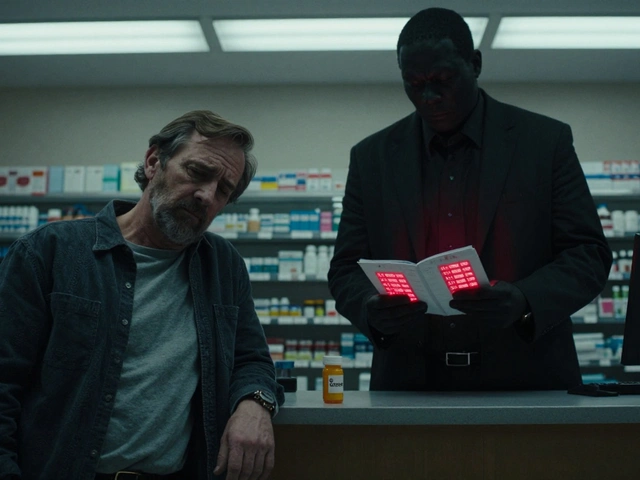Melasma in Men is a chronic hyperpigmentation disorder that primarily affects the facial skin of adult males. It shows up as stubborn brown or gray‑brown patches, most often on the cheeks, forehead, upper lip and chin. While the condition is traditionally associated with women, up to 10% of cases occur in men, and the underlying biology is surprisingly similar.
hyperpigmentation refers to excess melanin production leading to dark patches on the skin. In melasma, the excess melanin is not a sign of skin cancer but a response to internal and external triggers that overstimulate melanocytes, the pigment‑producing cells in the basal layer of the epidermis.
Why Men Develop Melasma
Three big groups of factors push melanocytes into overdrive for men:
- UV radiation: UV radiation (ultraviolet light) triggers melanin synthesis and can worsen melasma. Outdoor work, sports and inadequate sun protection are common culprits.
- Hormonal influences: Unlike women’s estrogen‑driven melasma, men often have a androgenic hormones such as testosterone influence melanocyte activity and are a key driver in male melasma. Situations that spike androgens-like steroid use, testosterone therapy, or puberty-can ignite the condition.
- Genetic and skin‑type predisposition: The Fitzpatrick skin type classifies skin’s response to UV exposure, influencing melasma risk. TypesIII‑VI (medium to dark) produce more melanin and tend to hold onto it longer.
Secondary contributors include oxidative stress from pollution, chronic inflammation (e.g., acne), and certain medications (e.g., anti‑epileptics, lithium).
Spotting Melasma: What It Looks Like
Typical patterns in men are:
- Forehead mask: symmetric patches spreading across the forehead.
- Cheek‑to‑nose bridge: darkening that follows the nasolabial folds.
- Upper lip & chin: often mistaken for post‑shave irritation.
Unlike a freckle, melasma doesn’t fade with a single wash and may deepen during summer months. A skin‑type assessment and Wood’s lamp examination help differentiate it from other pigment disorders.
Treatment Options: From Creams to Lasers
Effective management usually requires a combination approach-topical agents to suppress melanin production and procedural interventions to remove existing pigment.
Topical Therapies
The backbone of melasma care is the hydroquinone a topical bleaching agent that inhibits tyrosinase, reducing melanin formation. Concentrations of 2% (over‑the‑counter) to 4% (prescription) are common.
Other evidence‑based actives include:
- Tretinoin: a retinoid that speeds up cell turnover and enhances hydroquinone penetration.
- Azelaic acid: 15‑20% formulas that inhibit tyrosinase and have anti‑inflammatory benefits.
- VitaminC (ascorbic acid): antioxidant that interferes with melanin synthesis and brightens skin.
- Niacinamide: reduces pigment transfer and improves barrier function.
Apply these agents at night, avoid overlapping with harsh exfoliants, and monitor for irritation.
Procedural Interventions
When creams fall short, dermatologists turn to targeted procedures:
- chemical peel applies acidic solutions to exfoliate pigmented layers and promote uniform skin tone. Glycolic (20‑35%) or trichloroacetic acid (10‑15%) are typical choices for men with moderate melasma.
- laser therapy uses targeted light energy to break down excess melanin. Q‑switched Nd:YAG (1064nm) works well for darker skin because it penetrates deeper with less epidermal heating.
- Microdermabrasion: a mechanical exfoliation method that can smooth superficial pigment but offers limited depth.
Procedures should be spaced 4‑6weeks apart, and post‑treatment sun avoidance is non‑negotiable.
Choosing the Right Path: A Quick Comparison
| Treatment | Typical Efficacy | Side‑effects | Downtime | Cost (AU$) |
|---|---|---|---|---|
| 2% Hydroquinone + Tretinoin | 30‑50% lightening in 8‑12weeks | irritation, rare ochronosis | None | 150‑300 (prescription) |
| Azelaic Acid 20% | 20‑40% in 12‑16weeks | Mild stinging | None | 120‑200 (OTC) |
| Glycolic Peel (30%) | 40‑60% after 3‑4 sessions | redness, peeling | 1‑2days | 80‑150 per session |
| Q‑switched Nd:YAG Laser | 50‑70% after 2‑3 sessions | temporary hyper‑/hypopigmentation | 1day | 250‑400 per session |
| Broad‑spectrum Sunscreen (SPF50+) | Prevents worsening, supports all other treatments | None | None | 30‑60 (monthly) |

Prevention: Keep New Patches at Bay
Prevention is often simpler than cure. The single most powerful tool is diligent sun protection:
- Apply broad‑spectrum sunscreen protects against UVA and UVB rays, essential for melasma control with SPF50 or higher every morning.
- Reapply every two hours outdoors, and after swimming or sweating.
- Wear a wide‑brim hat, UV‑blocking sunglasses, and breathable but tightly‑woven shirts.
Additional lifestyle tweaks help:
- Limit exposure during peak UV hours (10am‑2pm).
- Use gentle, fragrance‑free cleansers to avoid irritating the barrier.
- Avoid smoking and excess alcohol, both of which increase oxidative stress.
- Consider adding an oral antioxidant supplement (e.g., VitaminC 500mg twice daily) after consulting a dermatologist.
Managing Expectations & Aftercare
Melasma rarely disappears overnight. Most men see noticeable improvement within 8‑12weeks of consistent treatment, but maintenance is key. A typical regimen looks like this:
- Morning: Broad‑spectrum sunscreen + gentle moisturizer.
- Evening: Hydroquinone (or azelaic) + tretinoin, followed by a barrier‑repair cream.
- Monthly: In‑office chemical peel or laser, depending on response.
- Quarterly: Re‑evaluate hormone levels if you’re on steroids or testosterone therapy.
If irritation occurs, step back to a lower concentration or introduce a soothing serum containing niacinamide. Always keep a skin‑type diary-note weather, product changes, and flare‑ups-to help your clinician fine‑tune the plan.
Related Topics Worth Exploring
Melasma sits at the crossroads of several broader dermatology themes. Readers often ask about:
- How melasma differs from post‑inflammatory hyperpigmentation (PIH).
- The link between melasma and an increased risk of skin cancer due to chronic UV exposure.
- Best cosmetic camouflage products for men who need a polished appearance for work or media.
- Impact of diet-especially foods high in niacin or antioxidants-on pigment disorders.
These subjects are covered in separate articles within the Health and Medicine cluster, offering deeper dives for the curious reader.

Frequently Asked Questions
Can melasma affect men of any age?
Yes. While melasma most often appears in men aged 30‑50, teenagers who use anabolic steroids or have intense sun exposure can develop it earlier. Age influences skin‑type response, but the core triggers-UV, hormones, genetics-remain consistent.
Is hydroquinone safe for long‑term use?
When used under dermatologic supervision, hydroquinone is considered safe for up to 12months. After a year, a break of 2‑3months is recommended to reduce the rare risk of ochronosis (darkening). Always follow the prescribed concentration and monitor skin reactions.
Do over‑the‑counter products work?
OTC options like 2% hydroquinone, azelaic acid, or vitaminC serums can provide modest improvement, especially for early‑stage melasma. For deeper or stubborn patches, prescription‑strength actives combined with professional procedures give the best results.
Will sunscreen alone clear melasma?
Sunscreen won’t erase existing pigment, but it stops further darkening and maximizes the effect of any treatment you’re using. Think of it as the foundation of every melasma plan.
Are there any natural remedies that actually work?
Topical agents with licorice extract, mulberry, or kojic acid have shown modest depigmenting effects in small studies. They are best used as adjuncts to proven treatments, not as stand‑alone cures.
Can lifestyle changes reverse melasma?
Lifestyle tweaks-strict sun avoidance, quitting smoking, balancing hormones-slow the progression and support medical therapies. They rarely reverse long‑standing patches without additional treatment.
Is laser therapy safe for darker skin tones?
Yes, when the appropriate wavelength (e.g., 1064nm Nd:YAG) and skilled practitioner are chosen. The laser’s deeper penetration reduces the risk of post‑inflammatory hyperpigmentation, which is a common concern for FitzpatrickIV‑VI skin.






EDDY RODRIGUEZ
September 25, 2025 at 12:34
Man, I feel you on the melasma struggle – it’s like fighting a shadow that loves the spotlight. You’ve nailed the basics: sunscreen, hydroquinone, and staying out of the midday blaze. Keep your routine rock‑solid for at least eight weeks before you judge the results; patience is the secret weapon. If you’re hitting a plateau, consider adding a niacinamide serum to soothe the barrier and boost pigment fade. Remember, the skin’s a marathon, not a sprint, so celebrate every shade‑lightening win. Stay relentless and you’ll out‑shine those stubborn patches!